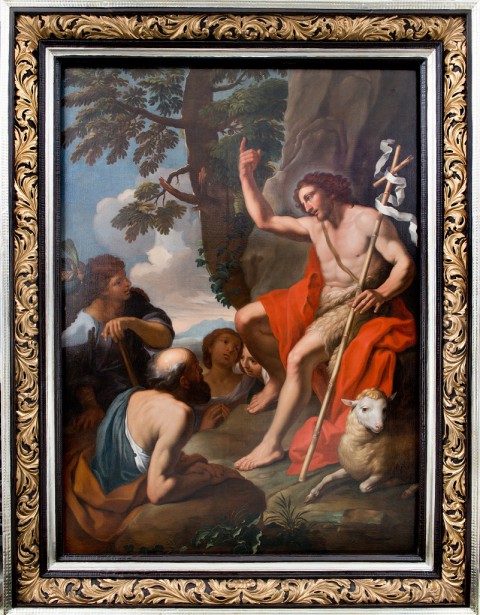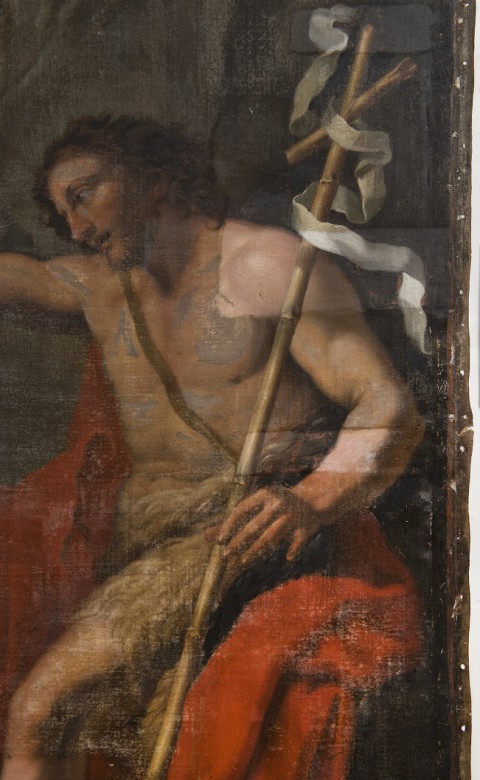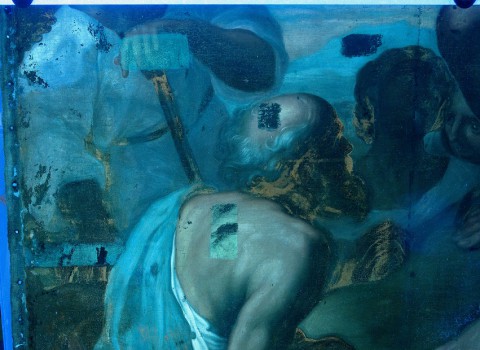Conservation and restoration works on Jan Reisner’s “Sermon of St John the Baptist”

Starting in March 2017, conservation of the painting Sermon of St John the Baptist, ascribed to Jan Reisner or his workshop, was carried out at the Museum of King Jan III’s Palace at Wilanów. The work, which is preserved at the Church of the Visitation Sisters in Krakow, was presented at the Jan III Sobieski: A Polish King in Vienna exhibition in Vienna’s Belvedere, and can be seen until the 3rd of December in the Grand Vestibule of the Wilanów Palace.
Conservation of the painting was a major challenge due to the significant degree of damage to the work, which required extensive preservation and reconstruction measures. The weakening of the structure of the historical painting constituted a serious threat to its further survival.
The painting, displayed on the side altar of the church, was exposed to changing environmental conditions and humidity for a long time, which led to damage. The cracked layers of the painting had very poor adhesion to the canvas and became deformed in many places, creating flakes that were in danger of falling away. The instability of the technological layers required the whole surface to be secured with Japanese tissue paper before the painting was removed and transported to the conservation workshop at the Palace Museum in Wilanów.
It was only here that it was possible to fully assess, conduct studies and finally develop a programme of the work necessary to save the painting.
Not without significance for the state of the painting, interventions and renovations were performed in the past, which, due to improperly selected methods, only worsened its condition. The canvas, consisting of two pieces connected by a vertical seam, had numerous holes and tears on the edges, resulting from corrections of the format and multiple instances of stretching the painting onto stretcher bars. During the previous work, an attempt was also made at isolating the canvas from harmful external factors by covering its back side with a thick layer of brown paint. Extensive cleaning of the surface led to large losses of significant fragments of the composition, which were later filled in, with simultaneous re-painting of neighbouring areas. Over time, the colours of the inept reconstructions underwent changes, which have become visible in the form of dark spots, noticeable even from a distance.
The aim of the operations undertaken at the museum was to carry out full conservation and restoration of the painting.
After attempts to consolidate the weakened painting and fragile canvas, a decision was made to join all the technological layers together and line the original canvas with new fabric. Before the doubling, the brown paint was removed from the reverse, otherwise it would have blocked the binding agent from penetrating all the separated layers. Small gaps in the canvas were bound and patched. The canvas, stripped of the thick layer of paint, regained its elasticity, which also had an impact on the deformation of the painted layers on the face of the painting. After removal of the Japanese tissue paper, the surface of the painting was chemically cleaned of extensive repainting and darkened varnish so that the impurities and secondary build-ups would not become entrenched during the consolidated at an elevated temperature.
The doubling was carried out on a low-pressure vacuum table, using thermoplastic doubling putty. Full structural homogeneity was achieved after filling in missing primer.
The final stage of the work was to restore the former appearance of Reisner’s painting to the maximum extent. With the repainted parts removed, it regained its saturated colours, but required significant restorations, particularly in the dark, thinly-painted parts, completely washed away in the past.
Reconstructions and mimetic retouching currently allow us to admire a high-quality painting, which is a satisfying result of the restoration carried out. The image is further enhanced by a gilded frame, which has undergone conservation measures. The methodology used during the procedures and materials introduced should ensure that the image remains in satisfactory condition for years to come, but it will certainly require constant control due to the difficult display conditions in the church.
Documentation and physicochemical tests are an essential part of the work undertaken in the museum. The latter consist of preliminary tests using white, UV and IR light, microscope observation, as well as tests conducted on samples taken from the layers of the painting, which, after completion, will allow for the identification of materials, pigments and binding agents used in the original.
The information obtained, which is important for safely carrying out conservation work, will also make it possible to determine the technique characteristics of Reisner’s painting, which will be important for further comparative works aimed at learning about the works of the artists of the Polish royal court.
suggested

Storage Accessible for Visitors
The Storage Accesible for Visitors is an exhibition area created in Markoniówka – a small, three-storey building adjacent to the …
















